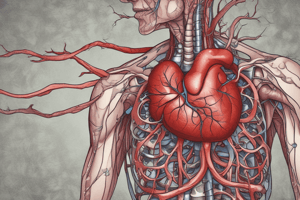Podcast
Questions and Answers
What is the primary site of exchange between blood and tissues?
What is the primary site of exchange between blood and tissues?
- Capillaries (correct)
- Venules
- Veins
- Arteries
Which blood vessels have thick, elastic walls to accommodate high blood pressure?
Which blood vessels have thick, elastic walls to accommodate high blood pressure?
- Capillaries
- Venules
- Veins
- Arteries (correct)
What type of blood vessels rely on the contraction of surrounding muscles to help move blood back to the heart?
What type of blood vessels rely on the contraction of surrounding muscles to help move blood back to the heart?
- Veins (correct)
- Capillaries
- Arteries
- Venules
Which component of the circulatory system ensures that every cell in our bodies receives essential nourishment?
Which component of the circulatory system ensures that every cell in our bodies receives essential nourishment?
Which type of blood vessels carry oxygen-poor blood back to the heart?
Which type of blood vessels carry oxygen-poor blood back to the heart?
What is the main responsibility of the circulatory system?
What is the main responsibility of the circulatory system?
Which type of circulation carries oxygen-poor blood from the heart to the lungs?
Which type of circulation carries oxygen-poor blood from the heart to the lungs?
Where does the blood pick up oxygen and release carbon dioxide in the circulatory system?
Where does the blood pick up oxygen and release carbon dioxide in the circulatory system?
Which part of the heart starts the systemic circulation by pumping blood through arteries to the body's tissues?
Which part of the heart starts the systemic circulation by pumping blood through arteries to the body's tissues?
What is the primary function of arteries in the circulatory system?
What is the primary function of arteries in the circulatory system?
Study Notes
The Circulatory System: Exploring Blood Circulation and Blood Vessels
At the heart of life is the circulatory system, a network of blood vessels that carry life-sustaining fluids throughout our bodies. This complex system is responsible for the circulation of oxygenated blood and the removal of waste products, ensuring that our organs receive the nutrients they need to function and thrive.
Blood Circulation
The circulatory system is made up of two separate loops: the systemic circulation and the pulmonary circulation.
The systemic circulation begins with oxygen-rich blood from the left ventricle of the heart, which pumps blood through arteries to the body's tissues. The blood then travels through capillaries, where nutrients and oxygen are exchanged for waste products, ultimately returning to the right atrium of the heart via the systemic veins.
The pulmonary circulation is a one-way loop that carries oxygen-poor blood from the right ventricle of the heart to the lungs, where it picks up oxygen and releases carbon dioxide. The oxygen-rich blood then returns to the left atrium and the cycle begins anew.
Blood Vessels
Blood vessels serve as the circulatory system's infrastructure, transporting blood in a controlled fashion and ensuring that it reaches all cells and tissues. These vessels can be classified into three primary types:
-
Arteries are the blood vessels responsible for carrying oxygen-rich blood away from the heart. They have thick, elastic walls to accommodate the high pressure of the blood they carry.
-
Capillaries are the smallest blood vessels and the primary site of exchange between blood and tissues. They connect arterioles and venules, allowing nutrients, oxygen, and waste products to cross their thin walls.
-
Veins are blood vessels that carry oxygen-poor blood back to the heart. They have thinner walls than arteries and rely on the contraction of the surrounding muscles to help move blood back to the heart.
The circulatory system is a marvel of biology, delivering essential nutrients and removing waste products with remarkable efficiency. This symphony of blood vessels, pumping hearts, and life-sustaining fluids ensures that every cell in our bodies receives the vital nourishment it needs to thrive and grow.
Studying That Suits You
Use AI to generate personalized quizzes and flashcards to suit your learning preferences.
Description
Explore the intricate network of blood vessels and the crucial process of blood circulation in the human body. Learn about the systemic and pulmonary circulation, as well as the roles of arteries, capillaries, and veins in sustaining life.




